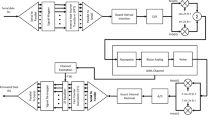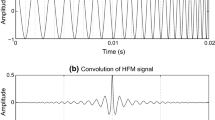Abstract
The use of clean communication paths underwater can enable important applications not only for the human being. Predictions of water-observation systems (e.g., oxygen levels, climate recording, pollutant contents) and monitoring/imaging animal activity (e.g., fish, micro-organisms) could anticipate actions to preserve underwater life in case of natural disturbances. Thus, a well-designed underwater communication system goes beyond military and commercial applications, it is an agent to safeguard ocean and rivers lives. This work contributes to an underwater link design at evaluating the performance of two emerging waveforms techniques (OFDM and GFDM) and the classic FSK over an underwater acoustic channel. Large scale fading effects, including multipath fading, Doppler spread, and geometric issues are addressed. In addition to the well-known ability to combat multipath in electromagnetic channels, OFDM and GFDM are chosen due to their efficient use of bandwidth and higher data rate compared to the current underwater FSK modems. We analyze the performance of those techniques, as well as their similarities and differences in terms of the Bit Error Rate and Bitrate, evidencing that there is a performance tradeoff to be taken into account when choosing the waveform of submarine systems.









Similar content being viewed by others
References
Demirors, E., Sklivanitis, G., Melodia, T., Batalama, S. N., & Pados, D. A. (2015). Software-defined underwater acoustic networks: Toward a high-rate real-time reconfigurable modem. IEEE Communications Magazine, 53(11), 64. https://doi.org/10.1109/MCOM.2015.7321973.
Uribe, C., & Grote, W. (2009). Model, radio communication, & for underwater WSN. In Proceeding of mobility and security 2009 3rd international conference new technologies (pp. 1–5). https://doi.org/10.1109/NTMS.2009.5384789.
Akyildiz, I. F., Wang, P., & Sun, Z. (2015). Realizing underwater communication through magnetic induction. IEEE Communications Magazine, 53(11), 42. https://doi.org/10.1109/MCOM.2015.7321970.
Rappaport, T. (2001). Wireless Communications: Principles and Practice, Wireless Communications: Principles and Practice (2nd ed.). Upper Saddle River, NJ: Prentice Hall PTR.
Kilfoyle, D. B., Preisig, J., & Stojanovic, M. (2000). Guest editorial special issue on underwater acoustic communications. IEEE Transactions on Oceanic Engineering, 25, 2–3.
Sampath, H., Talwar, S., Tellado, J., Erceg, V., & Paulraj, A. (2002). A fourth-generation MIMO-OFDM broadband wireless system: design, performance, and field trial results. IEEE Communications Magazine, 40(9), 143.
Hammoodi, A., Audah, L., & Taher, M. A. (2019). Green coexistence for 5G waveform candidates: A review. IEEE Access, 7, 10103–10126.
Gaspar, I. S. (2016). Waveform advancements and synchronization techniques for generalized frequency division multiplexing. Master’s thesis, Technische Universität Dresden.
Michailow, N., Matthé, M., Gaspar, I. S., Caldevilla, A. N., Mendes, L. L., Festag, A., et al. (2014). Generalized frequency division multiplexing for 5th generation cellular networks. IEEE Transactions on Communications, 62(9), 3045. https://doi.org/10.1109/TCOMM.2014.2345566.
Wolff, L. M., Badri-Hoeher, S., & Noack, S. (2017). Bitwise ranging through underwater acoustic communication with frequency hopped FSK utilizing the Goertzel algorithm. In IEEE OCEANS 2017-Aberdeen.
Dong, J. G., Sun, D. J., Zhang, Y. W., & Fan, W. W. (2014). FH-FSK underwater acoustic control and communication system based on LDPC code. https://doi.org/10.4028/www.scientific.net/AMM.511-512.375.
Fan, W. W., Liu, L., Zhang, Y. W., Dong, J. G., & Sun, D. J. (2014). An MMSE approach to channel shorting for underwater acoustic FH-FSK communication, sensors. Mechatronics and Automation,. https://doi.org/10.4028/www.scientific.net/AMM.511-512.334.
Liu, L. (2020). Iterative multi-channel FH-MFSK reception in mobile shallow underwater acoustic channels. IET Communications, 14(5), 838.
Hu, X., Wang, D., Lin, Y., Su, W., Xie, Y., & Liu, L. (2016). Multi-channel time frequency shift keying in underwater acoustic communication. Applied Acoustics, 103(PA), 54. https://doi.org/10.1016/j.apacoust.2015.10.009.
Walree, P. A. V., Buen, H., & Otnes, R. (2014). A performance comparison between DSSS, M-FSK, and frequency-division multiplexing in underwater acoustic channels, 2014 underwater communications and networking (UComms) (pp. 1–5).
Qiao, G., Song, Q., Ma, L., Sun, Z., & Zhang, J. (2020). Channel prediction based temporal multiple sparse bayesian learning for channel estimation in fast time-varying underwater acoustic OFDM communications. Signal Processing, 175, 107668. https://doi.org/10.1016/j.sigpro.2020.107668.
Wan, L., Jia, H., Zhou, F., Muzzammil, M., Li, T., & Huang, Y. (2020). Fine Doppler scale estimations for an underwater acoustic CP-OFDM system. Signal Processing, 170, 107439. https://doi.org/10.1016/j.sigpro.2019.107439.
Qarabaqi, P., & Stojanovic, M. (2013). OFDM for underwater acoustic communications. IEEE Journal of Oceanic Engineering,. https://doi.org/10.1109/JOE.2013.2278787.
Zhang, Y., Venkatesan, R., Li, C., & Dobre, O. A. (2015). Compressed sensing-based time-varying channel estimation in UWA-OFDM networks. In 2015 international wireless communications and mobile computing conference (IWCMC) (pp. 1520–1525). https://doi.org/10.1109/IWCMC.2015.7289308.
Li, C., Song, K., & Yang, L. (2017). Low computational complexity design over sparse channel estimator in underwater acoustic OFDM communication system. IET Communications, 11(7), 1143. https://doi.org/10.1049/iet-com.2016.1215.
Beygi, S., & Mitra, U. (2015). Multi-scale multi-lag channel estimation using low rank approximation for OFDM. IEEE Transactions on Signal Processing, 63(18), 4744. https://doi.org/10.1109/TSP.2015.2449266.
Ahmed, S. (2015). Estimation and compensation of Doppler scale in UAC OFDM systems. In OCEANS 2015—MTS/IEEE Washington (pp. 1–12). https://doi.org/10.23919/OCEANS.2015.7401813.
Ramadan, K., Dessouky, M. I., Elagooz, S., et al. (2018). Equalization and carrier frequency offset compensation for underwater acoustic OFDM systems. Ann. Data. Sci., 5, 259–272.
Wang, Y., Zeng, Z., Li, Y., Zhang, J., & Jin, S. (2014). Multicarrier spread spectrum communication scheme for cruising sensor network in confined underwater space. IJDSN, 10, 1. https://doi.org/10.1155/2014/165749.
Bocus, M. J., Doufexi, A., & Agrafiotis, D. (2017). Performance evaluation of MIMO-OFDM/OQAM in time-varying underwater acoustic channels. In OCEANS 2017—Anchorage (pp. 1–6).
Agrafiotis, D. (2020). Performance of OFDM-based massive MIMO OTFS systems for underwater acoustic communication. IET Communications, 14(4), 588.
Wang, J., Zhang, X., & Zhu, Q. (2015). Statistical QoS-driven power adaptation over MIMO-GFDM based underwater wireless networks. In 10th ACM international conference on underwater networks and systems, WUWNet 2015 (1). https://doi.org/10.1145/2831296.2831340.
Hilario-Tacuri, A. (2019). A closed-form spectral analysis of GFDM in underwater communication systems. In Proceedings—2019 IEEE Latin-American conference on communications, LATINCOM 2019. https://doi.org/10.1109/LATINCOM48065.2019.8937919.
Hebbar, R. P., & Poddar, P. G. (2020). Generalized frequency division multiplexing for acoustic communication in underwater systems. International Journal of Communication Systems, 33(10), 86. https://doi.org/10.1002/dac.4292.
Zhong, Z., & Guo, J. (2016). Bit error rate analysis of a MIMO-generalized frequency division multiplexing scheme for 5th generation cellular systems. In Proceedings IEEE international conference electronic information and communication technology (ICEICT) (pp. 62–68). https://doi.org/10.1109/ICEICT.2016.7879653.
Akai, Y., Enjoji, Y., Sanada, Y., Kimura, R., & Sawai, R. (2016). GFDM with different subcarrier bandwidths. In Proceeding of IEEE 84th vehicular technology conference (VTC-Fall) (pp. 1–5). https://doi.org/10.1109/VTCFall.2016.7881030.
Ozturk, E., Basar, E., & Cirpan, H. A. (2016). Generalized frequency division multiplexing with index modulation. In Proceedings of IEEE Globecom workshops (GC Wkshps) (pp. 1–6). https://doi.org/10.1109/GLOCOMW.2016.7848916.
Öztürk, E., Basar, E., & Çirpan, H. A. (2017). Generalized frequency division multiplexing with flexible index modulation. IEEE Access, 5, 24727. https://doi.org/10.1109/ACCESS.2017.2768401.
Wei, P., Xia, X. G., Xiao, Y., & Li, S. (2016) Low-complexity DGT-based GFDM receivers in broadband channels. In Proceedings of IEEE international conference communication systems (ICCS) (pp. 1–6). https://doi.org/10.1109/ICCS.2016.7833550.
Dias, J. T., & de Lamare, R. C. (2017). Unique-word GFDM transmission systems. IEEE Wireless Communications Letters, 6(6), 746. https://doi.org/10.1109/LWC.2017.2738641.
Huang, J., Wang, H., He, C., Zhang, Q., & Jing, L. (2018). Underwater acoustic communication and the general performance evaluation criteria. Frontiers of Information Technology & Electronic Engineering, 19(8), 951. https://doi.org/10.1631/FITEE.1700775.
Roul, S., Kumar, C., & Das, A. (2019). Ambient noise estimation in territorial waters using AIS data. Applied Acoustics, 148, 375. https://doi.org/10.1016/j.apacoust.2018.07.036.
Suganthbalaji, R., Elizabeth Shani, N. X., Nair, N. R., & Nair, P. V. (2019). Effect of environment on underwater acoustic communication data rates. Defence Science Journal, 69(2), 163. https://doi.org/10.14429/dsj.69.14227.
Wang, X., Wang, X., Jiang, R., Wang, W., Chen, Q., & Wang, X. (2019). Channel modelling and estimation for shallow underwater acoustic OFDM communication via simulation platform. Applied Sciences, 9(3), 1. https://doi.org/10.3390/app9030447.
de Luna, D. R., Dantas, I. A. N., Sousa, L. C., & de Sousa Jr., V. A. (2017). OFDM over underwater acoustic channel with large and small scale fading. In The international conference on computational science and computational intelligence (CSCI-ISMC).
Andrade, I., & Campos, M. (2017). Performance evaluation of multicarrier systems applied to underwater acoustic communications. In XXXV Simpósio Brasileiro de Telecomunicações e Processamento de Sinais.
Zhou, S., & Wang, Z. (2014). OFDM for underwater acoustic communications (1st ed.). Hoboken: Wiley Publishing.
Porter, M. (2008). General description of the bellhop ray tracing program. http://oalib.hlsresearch.com/Rays/GeneralDescription.pdf.
Vajapeyam, M., Mitra, U., Preisig, J., & Stojanovic, M. (2007). Distributed space-time cooperative schemes for underwater acoustic communications. In OCEANS 2006—Asia Pacific.
Qarabaqi, P., & Stojanovic, M. (2013). Acoustic channel simulator code. http://millitsa.coe.neu.edu/?q=research/simulator.
Maritime, K. (2018). Kongsberg maritime. https://www.kongsberg.com/.
Bocus, M. J., Doufexi, A., & Agrafiotis, D. (2016). Performance evaluation of filterbank multicarrier systems in an underwater acoustic channel. In 2016 IEEE 27th annual international symposium on personal, indoor, and mobile radio communications (PIMRC). IEEE (pp. 1–6).
Acknowledgements
The proof of concept simulations provided by this paper was supported by High Performance Computing Center at UFRN (NPAD/UFRN). This study was financed in part by the Coordenação de Aperfeiçoamento de Pessoal de Nível Superior - Brasil (CAPES) - Finance Code 001.
Author information
Authors and Affiliations
Corresponding author
Ethics declarations
Conflict of interest
The authors declare that they have no conflict of interest.
Additional information
Publisher's Note
Springer Nature remains neutral with regard to jurisdictional claims in published maps and institutional affiliations.
Rights and permissions
About this article
Cite this article
de Luna, D.R., de Sousa, L.C. & de Sousa, V.A. Multicarrier Systems Over Underwater Acoustic Channels: A Performance Evaluation. Wireless Pers Commun 117, 1537–1555 (2021). https://doi.org/10.1007/s11277-020-07934-7
Accepted:
Published:
Issue Date:
DOI: https://doi.org/10.1007/s11277-020-07934-7




